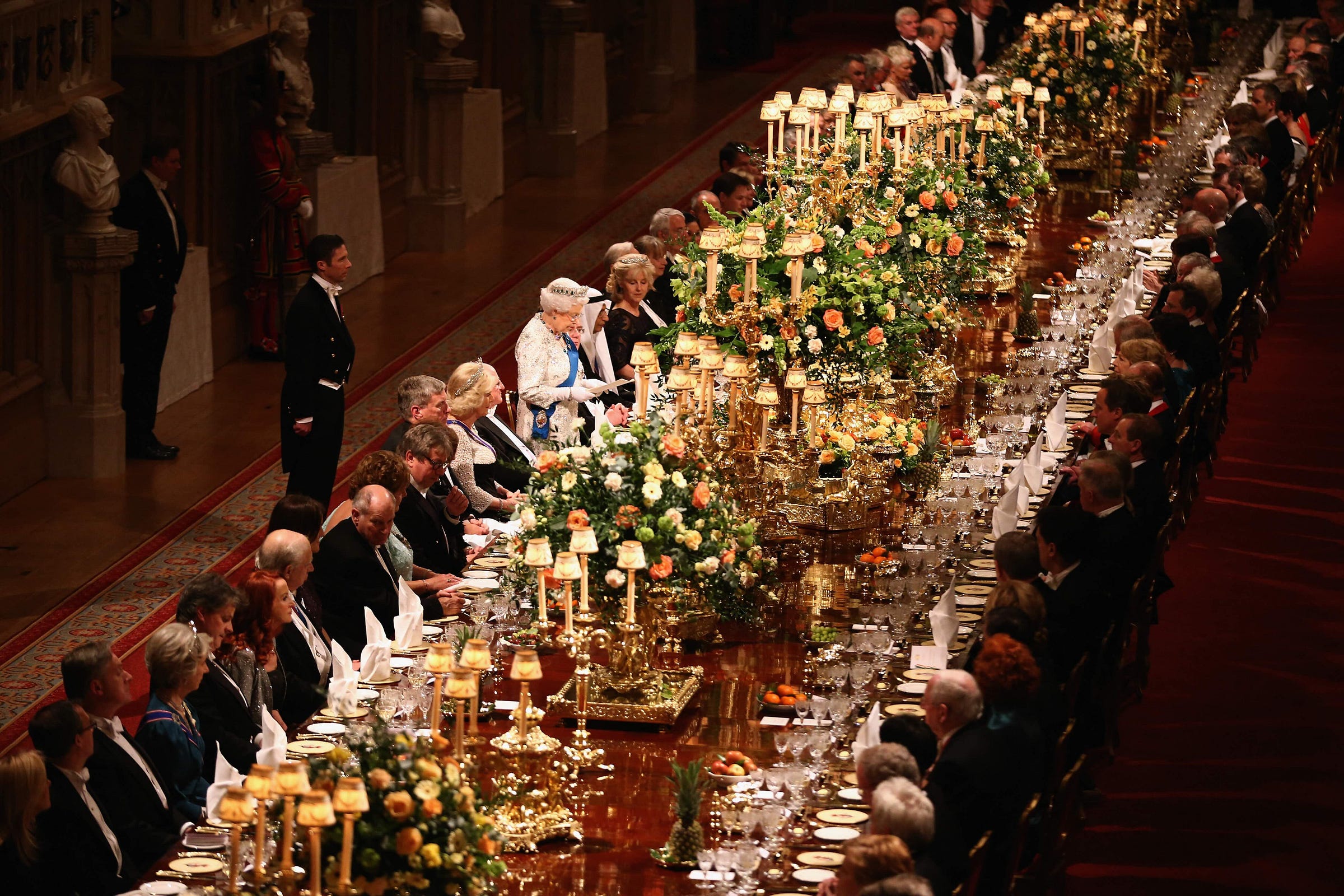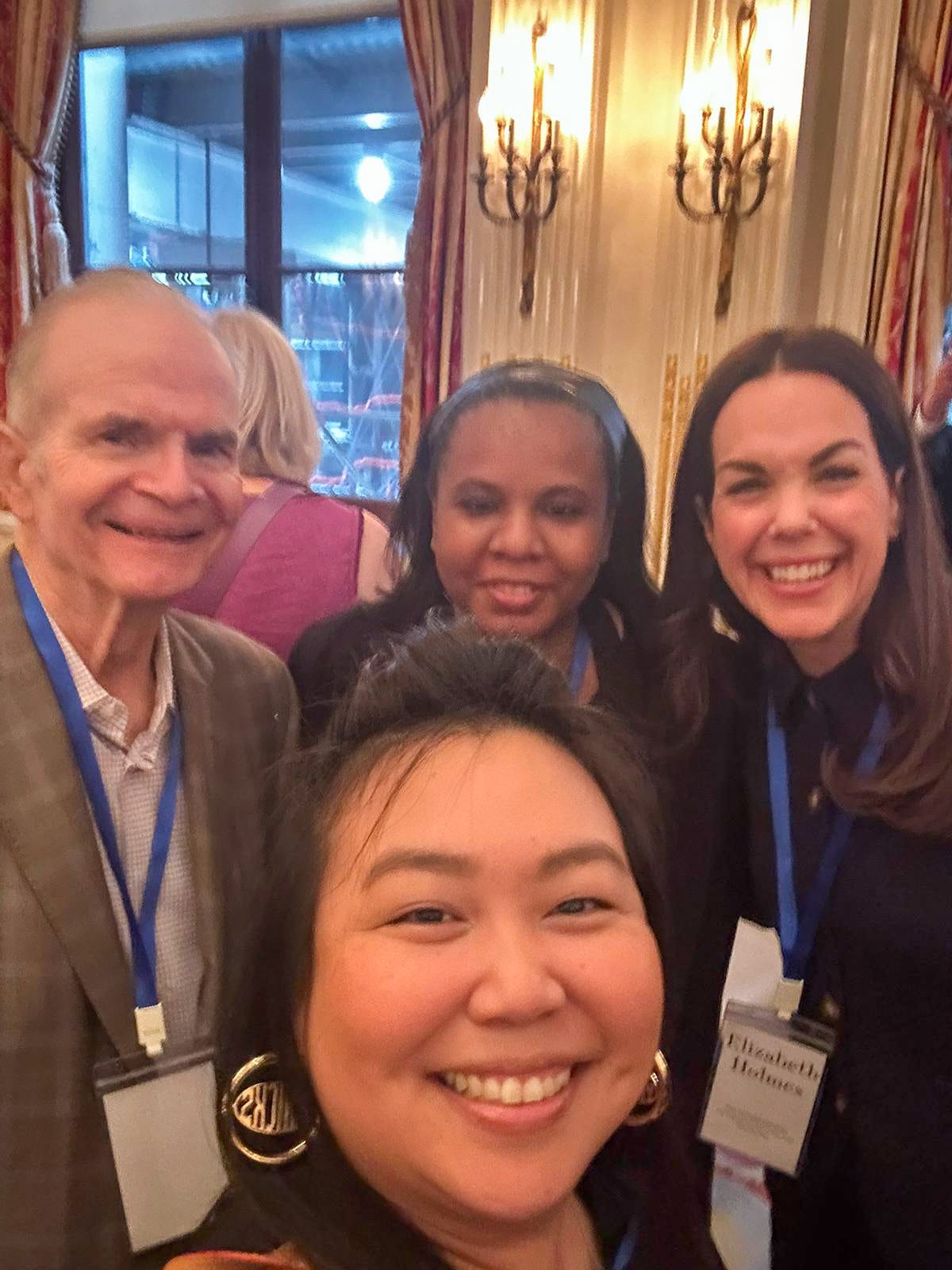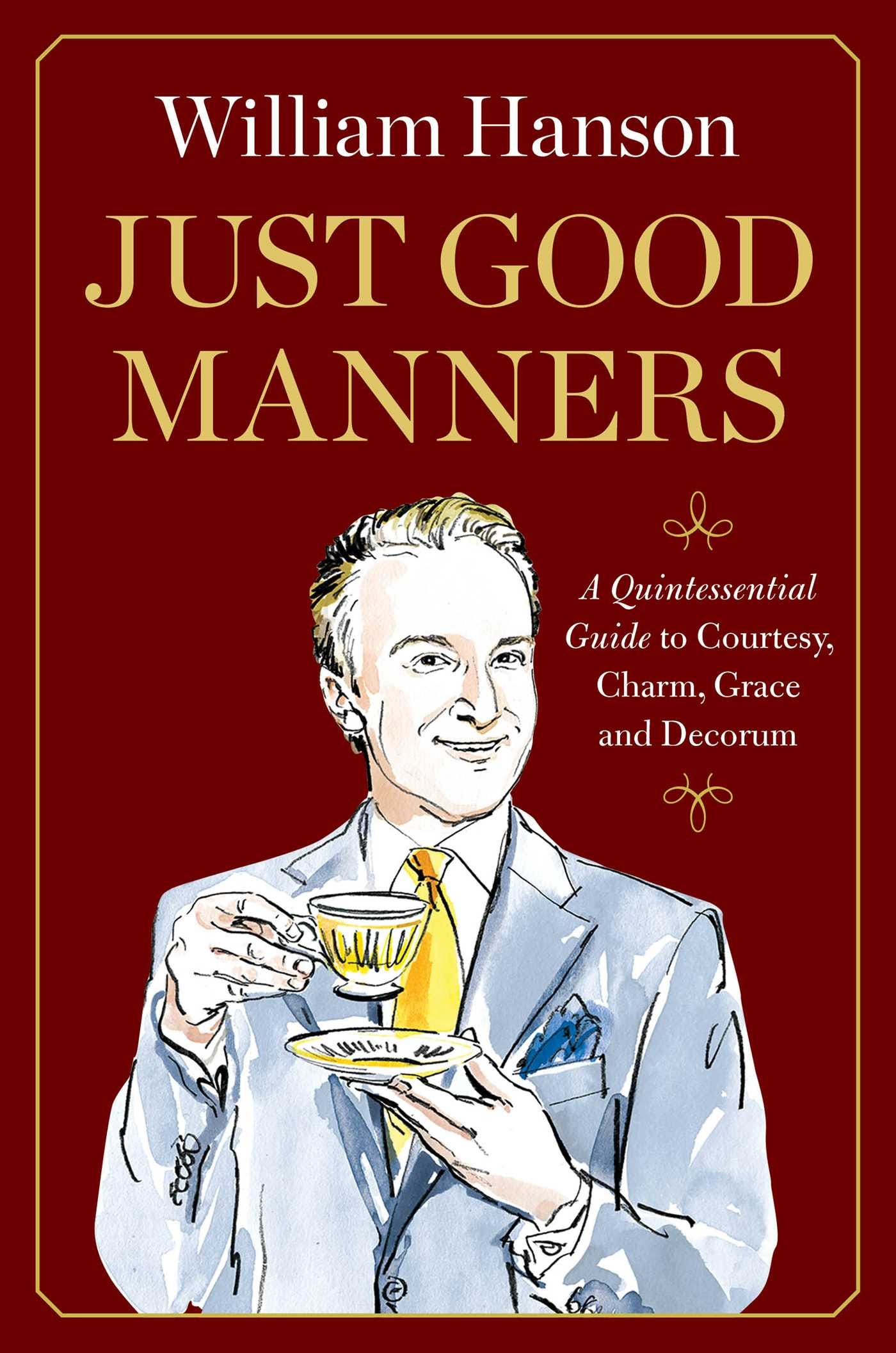Think Etiquette Is Old-Fashioned? Think Again
William Hanson, the blonde British social media standout and author of the new book ‘Just Good Manners,’ makes the case.
Last week, I flew to New York in part to attend a Wall Street Journal reunion. The event, organized by some of the biggest names in the paper’s recent history, was held at the University Club, just off of Fifth Avenue. The members-only venue has a strict dress code, which was the talk of my group chat ahead of time, as well as other rules, including specific directions on when and how to use electronic devices.
I selected my outfit decisively, trusting my Veronica Beard vest suit would satisfy the “tailored clothing” requirement for women. (My bare arms were permitted under the additional explanation: “Tailored pants paired with tailored/beaded tops may be worn without a jacket, sweater or scarf.”) At the reception, which was filled with storied editors, I held my wine glass by the stem and made polite, brief small talk, saving the dishier bits for my friends afterwards. Although photography was not permitted at the club, I even took and posed for a few pictures at the end, trusting that our private event allowed for an exception. (And yes, my friend asked WSJ legend Paul Steiger if we could snap a selfie with him first, to which he delightfully agreed.)
All of this I did with confidence — and the distinct voice of etiquette coach William Hanson ringing in my ears. The blonde Brit has amassed millions of followers on Instagram and TikTok with videos on everything from how to hold a fork to how to address members of the royal family. We connected last week on the day his new book, Just Good Manners: A Quintessential Guide to Courtesy, Charm, Grace, and Decorum, was published here in the U.S.
I must admit, I began reading it with a fair amount of skepticism. While I delight in the time travel offered by Downton Abbey (sidenote: have you seen the new movie trailer?) much of the field of etiquette can feel best left to that bygone era. Do we really need to debate whether a bread knife is placed on the plate or above it? Must we use the term “present” when introducing one guest to another, titled one? Does it really matter if, when attending Royal Ascot, one departs from charcoal gray morning dress and opts for dove gray instead? It can all quite quickly seem outdated or, worse, exclusionary and elitist.
Hanson, however, made a compelling case in both his book and our conversation that knowing what is expected can put people at ease. Having a firm grasp on the proper form for any given situation means more energy and attention can be directed toward the matter at hand. (I will say, I did feel a bit more self assured milling around a room filled with Journal notables. These are the people who intimidated me when I began at the newspaper and, all these years later, still have a similar effect.) What’s more, Hanson is an advocate for the ways in which etiquette must evolve. Gender-based rules, for example, are going by the wayside.
Below, Hanson details the difference between manners and etiquette and makes the case for why this is relevant today. Keep scrolling for his take on the notable differences between Brits and Americans (spoiler: the latter is louder), the importance of dressing up (you know I support this), and two golden rules to keep in mind when commenting on social media (which I wish everyone would follow).
Just Good Manners is available wherever you get your books. You can request a copy from your local independent bookstore, as well as find it on Bookshop.org and other online retailers.
***GIVEAWAY CLOSED***
🫖 Just Good Manners Giveaway!
The team at Gallery Books has generously offered to give away three copies of Just Good Manners to So Many Thoughts readers. To enter, I ask that you 1) tap the heart button at the top of this email, which will help others find the newsletter and 2) leave a comment (it can be something as simple as an emoji or more specific, like an etiquette rule you enjoy — or could do without). Best of luck!
Giveaway closes Thursday, June 5 at 5pm PT. Open to US addresses only. Winners will be chosen at random and notified via email.
William Hanson on Etiquette in Modern Times
Please note: Our conversation has been edited and condensed.
William, hello! How did you find your way into the field of etiquette?
William Hanson: I wasn’t even aware it was a job. My late grandmother gave me a book of etiquette for Christmas when I was 12. Not because she thought I needed it — she thought I would appreciate it, which I did. When I sat down to read it, there were bits that spoke to me. I found I was able to remember supposedly inane details, like tablecloths for a buffet should hang and touch the floor, whereas for a lunch you would have it slightly higher. That sort of thing, which, of course, has no use whatsoever at school. You could also argue very little use in life itself. It was a subject that stuck in my head.
When I was 16, my school asked if I could teach the younger years how to set a table. And I said, “Well, does that mean I don’t need to play rugby?” They said, “Yes, that’s fine.” Sign me up! I started teaching every week. A few months in I thought, I quite like this. I did some Googling — this was the primitive days of the internet — and discovered: Oh gosh, this is a career. That’s how it started.
What is the difference between manners and etiquette?
Manners are the ultimate goal. Every society is geared to being well-mannered, having respect for one’s self and other people, not doing anything that is going to make someone feel uncomfortable. Every society agrees that we need that.
How we achieve a state of being well-mannered is by using a set of rules. Those rules we call the etiquette. Ninety percent of the time, the etiquette is correct. Sometimes it isn’t. In order to be more well-mannered in a specific situation, you have to sort of throw out what I say in Just Good Manners — or you might have been taught by parents or grandparents — in order to be more well mannered. But generally, I would say you have to know what the rules are so that when you do come to break them, you can break them with confidence and dexterity rather than just blindly hoping that your winning smile will get you through it.
What role do manners and etiquette play in modern times?
It is about civility and respect and compassion. The rules of etiquette may change over time, in terms of the actual mechanics, but the guiding core principles will always remain true and relevant. I often think people who say, “We don’t need this anymore” are actually rather badly masking their own insecurity or lack of knowledge. Treating others with respect is part of the bargain of being a human. Anyone who says that that isn’t needed could be politely pushed off the planet — or maybe put onto another planet.
This field can feel at times a bit exclusionary. But you make the case in your book that it is meant to put people at ease.
Knowing what is expected of oneself — in a social situation, a professional situation — is helpful. Even in modern parenting, children need parameters and expectations. As a child, we are aware of what we are meant to do at school or at home. It’s no different for adults. If we know what is expected of us, and the parameters for playing nicely, then we can be our best selves. We can then focus on actually things that are arguably more important.
For example, you are on a date and you both decide to share the spaghetti lobster. Well, if you can eat spaghetti relatively nicely and lobster without getting it everywhere, without getting a piece of shell in your date’s eye, you don’t need to sit there going, “Oh my gosh, how the heck do I eat this spaghetti lobster that we’ve just decided to order?” You can focus on building that rapport with the person sitting opposite the table.
Early on in Just Good Manners, you underscore the role of humility. I appreciated that reframe.
Yes, being aware of one’s self and one’s limitations. There was an interview I did in Britain where I was asked how to respond when someone says, “How was your holiday or vacation?” Really, other than very close family and maybe your best friend, nobody is really that interested. They want to know you have had a nice time, but they don’t really need to know “on Tuesday I did that and on Wednesday we did this and here are 400 photographs to sit through.”
Social media in particular, which of course has changed how we interact with others for good and for bad, has kidded ourselves into thinking that everyone is interested in everything that we do. My new pet hate, though they have been around for awhile now, are these “Get ready with me” videos on Instagram. Or: “Here’s what I ate in a day.” I don’t care. I don’t think anyone really cares. I don’t want to get ready with myself let alone with some random person on the internet. This is a lack of awareness, of humility. We are kidding ourselves that we are the most fascinating creatures.
It’s quite clear that Brits and Americans approach etiquette differently. What are some examples of that?
Etiquette does change from country to country. What one country considers correct another may actually think is not correct, so there is a bit of flex there. Americans — and not all Americans, I would like to caveat all of this, I am speaking in broad brush strokes here — but compared to Brits, you’re quite loud as a nation. You have got a larger country, so in many ways you can be. In Britain, obviously, we’re a microscopic country. Most of your states are bigger than the entirety of the UK put together. We don’t have a lot of space. And so I think our geographical fortune, or misfortune, has caused us to be relatively quiet in comparison. I was sitting in a restaurant in Boston only on Sunday night, and the woman on the banquette behind me was so loud. It was a loud restaurant anyway, a very busy restaurant, but we could hear every word of what she was saying.
In many ways, we can learn something from Americans in Britain. Americans seem to start off enthusiastic, optimistic and, when you meet someone, almost overly effusive. Whereas in Britain, we can come across as a bit cold to begin with. In American, you start friendly. Whereas to a Brit, we think: Why are they being so overly friendly? And we don’t trust that necessarily. That is beginning to change with the younger generations. But we would start with: Hang on, why are you being so friendly to me? In Britain, you have to earn that status.
What is the best path forward? Do you follow the etiquette of your geographic location?
I start the book with — it is meant jokingly — “When in Rome, do as the British do.” But yes, when in Rome, do as the Romans do. I have been in New York for a week now and I have got another week to go. I’m finding myself a little bit more optimistic at points. New York, in particular, has that air of optimism that you walk down the street and you just feel like you can conquer the world. The default answer in America generally is “Yes” or “Yes, how can we do that?” Whereas in Britain, it’s, “No, we tried that once. It didn’t work.”
How has etiquette evolved?
Etiquette has to change in order to survive. Some of my older correspondents say, “Well, I know everything because my parents taught me everything.” They are now in their 60s or 70s. And I say, “Well, that’s fantastic. However, whatever you have been taught, at least a third of that is going to change.” I really hope that what I have written in Just Good Manners now, at least a third of it will be out of date in 50 years’ time, because how we interact with people does change.
Gender is a big one. If pulling out a chair, for example, you pull out a chair for whoever you are sitting next to, whether you are male identifying, female identifying, non-binary, it doesn’t matter. They are a human being next to you. Pull their chair out if you want to. As I write in the book, there is something really refreshing about seeing a lady pulling out a chair for a man. I think it’s quite nice.

I am curious about the role of the British Royal Family here. How much did you seek to include them? There are mentions throughout your book, as well as an entire chapter at the end.
A lot of the British etiquette books, certainly published in the 20th century, start with: “You are off to a state banquet at Buckingham Palace.” Your average person, British or American, is not. Etiquette is for everyone. You don’t have to be royal or be meeting members of royal families to follow good manners.
I had no intention of doing anything royal. I wrote the book and the conclusion, which mentioned the royal family. And I wrote to my editor in Britain and said, “Look, I just don’t think we can do a book on British manners and not talk about the royal family. It would feel odd.” It is the shortest chapter in the book. I have bent over backwards to move it away because there are lots of really other great books that you can go to if you need that.
But also, I felt there were new areas to talk about other than just the classic “Your Majesty, sir, ma’am thing.” Harry, Meghan and Andrew, for example. There is no book up until now that deals with: How do you address them, as they are in that limbo state for different reasons? That’s what I wanted Just Good Manners to do, talk about areas that your traditional etiquette book isn’t talking about.
Let’s talk about dress codes. You write that it used to be considered vulgar to be overdressed, whereas now it is a rather rare occurrence.
People very rarely dress up for things anymore, which is a great shame. By dressing up — and, of course, our definitions of dressing up have changed — we are showing respect to the country, the company, the person, the organizer of that particular event. Looking as if we have just rolled in from bed, or the gym, which often happens, is a disrespect, really. It’s so much better to be overdressed at an event than underdressed. Underdressed is terrible. You just feel awkward.
Our clothes inform how we are thinking. I couldn’t teach an etiquette class if I was in my gym gear, because I just would not be in the right state of mind. That’s why I’m sitting talking to you today in a dinner jacket, obviously.
I can remember something one of my old headmasters at school said to us as we broke for spring break, when we would go to revise for our exams that we would do in the summer term. He strongly suggested that when we were revising at home we put on our school uniform. We all thought he was completely mad. But I did try it and thought, Gosh, you put on your school uniform and you do suddenly think I’m in learning mode. Whereas when you are trying to revise in your pajamas, you are in bed mode. What we wear can change how we behave.
Some people say, “Oh, it’s so uncomfortable wearing a suit and a shirt and a tie.” It’s only uncomfortable if you’re wearing ill-fitting clothes. If you haven’t updated your shirt in 10 years and your body has changed shape, then of course it’s going to be uncomfortable. If you’re wearing something that fits you, it should not be uncomfortable at all.
“Our clothes inform how we are thinking.”
What do you make of the royal family’s fashion? It does seem to be getting more casual, if ever so slightly.
The king and queen obviously dress the most formally out of all of them. That is because of their age, but also they are king and queen. It will be fascinating to see what happens when William and Catherine become king and queen. William, generally, is still quite formal compared to your average Brit, but is actually quite low-key in his dressing. I would hope that it goes just up a notch or two when he becomes king. Purely speculative, we shall see. Catherine, of course, is more royal than most members of the royal family put together and never gets a note wrong.

Charles has long favored suits and ties for daytime engagements, while William often turns up in a blazer without a tie. Does that bother you?
It would bother me if he were king. It doesn’t bother me now. He wears a tie on occasions that need a tie. You often see him, potentially, not in a tie if he’s at a daytime event. If it’s an evening reception, then there will be a tie. The royal household or his office will be completely aware of what everyone else at the event is wearing. And you do sort of want to look like you’re all going to the same event.
[EH note: One exception that comes to mind is the sneakers-and-no-tie ensemble at last year’s Earthshot.]
One last thing before I let you go. What advice do you have for etiquette when it comes to social media?
I think a good rule of thumb is: Would you say this to their face if they were standing in front of you?
With posting anything online, whether it’s a comment on someone’s Instagram post, a comment on a news article, a thing on Facebook, people feel emboldened to say something because there are no consequences necessarily. You are not seeing the reaction on someone’s face.
I posted something online, a photo of my husband and I on the Brooklyn Bridge, and someone commented, “That is an absolutely atrocious raincoat.” Ok, we don’t like the raincoat. It’s not a problem. I also got lots of compliments about the raincoat. Not everyone is going to like everything I wear. But you just think, if we were at a party and you actually met me, would you come up to me and say that to my face? I’m fairly convinced even the most nasty person wouldn’t. There is this almost safety that people wrongly think, “Oh, I can say what I like because there are no consequences and they’re not in front of me.” That’s a great shame.
I agree. Are there any other pieces of advice for infusing etiquette into social media?
People feel that they need to have an opinion on everything, that just because something is posted that they have to comment. No, you don’t. Because again, nobody’s that interested in your view necessarily.
Today I posted a picture of me holding my book and received a couple of slightly negative comments, which is odd. It’s just a photo of me holding my book. It’s not particularly divisive. Lots of people said, “Thank you” or “Congratulations,” etc. But I haven’t posted it necessarily to read the view of absolutely everybody who follows me. I’m just sort of posting it like: Woohoo! Milestone! But again, people think, “Oh, well, he’s posted it, so thus he is soliciting opinions and I have to give something.”
I do wonder, particularly for the people who say nasty stuff — and this is very philosophical — if it is a form of loneliness? That they don’t have anyone else to speak to? Are they using the people that they have chosen to follow as a way to have companionship? My heart goes out to them if they are lonely. But they’re not going to make friends if they say nasty things.
Just Good Manners offers an appendix at its conclusion with sample thank you letters, so I shall try my hand at one. (Imagine this is hand-written on a thick, monogrammed notecard.)
Dear William,
What a pleasure it was to chat with you! Thank you for your time and insight. I consider myself persuaded by your case for etiquette in modern times and will keep Just Good Manners close at hand for all future social engagements.
I do hope the knighthood you have manifested in your book comes through for you.
All the very best,
Elizabeth
For your part, dear reader, you can find William on Instagram here and may request a copy of Just Good Manners at your local independent book seller or the usual online retail outlets.
PS: Don’t forget to enter the giveaway! Like and comment for your chance to win one of three copies. Open to US addresses only












Obsessed with this whole convo especially the most killer line “Catherine is more royal that most of the royals put together”.
Letting women exit an elevator first maybe be outdated but to me shows that a man know proper etiquette 😉